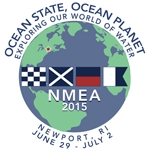Ecosystem experiences away from home
By Peggy Ashbrook
Posted on 2015-06-08
For children who visit the ocean beach or shore this summer, the experience of visiting a very different ecosystem can inspire interest in animals that inhabit it, and wonder about “how did it get this way?” Children who experience the beach and shore ecosystems frequently may have a similar reaction when visiting other ecosystems. How do we incorporate their questions and experiences into the classrooms in their home place?
 Some of us live in areas where we never see a sandy area in nature, much less a whole beach of it, so sand is a sensory experience rather than an exploration of the environment. Sand is a standard in early childhood programs because it feels so soothing as it pours through our fingers and we can build such interesting structures with wet sand. Sensory play provides a foundation for learning vocabulary, engaging socially with others, and learning about the properties of matter.
Some of us live in areas where we never see a sandy area in nature, much less a whole beach of it, so sand is a sensory experience rather than an exploration of the environment. Sand is a standard in early childhood programs because it feels so soothing as it pours through our fingers and we can build such interesting structures with wet sand. Sensory play provides a foundation for learning vocabulary, engaging socially with others, and learning about the properties of matter.
I’m thinking of some materials that can also be soothing and interesting yet be local, for my program:
 Leaves, dry or fresh, paired with scissors, or in water.
Leaves, dry or fresh, paired with scissors, or in water.- Dish soap bubbles in water (local as in every home).
- Rocks from a stream valley or landscape company (washed to remove pollutants that wash into streams.)
- Grass clippings if from a known pesticide- and fertilizer-free source.
Some of these materials may be appropriate for children of certain ages—you know your children. Some materials may only last for a day or two.
 To support children as they talk about their beach experiences on a trip away from home we can have a shell collection in the classroom to use for sorting, making impressions in playdough and incorporating into imaginative play. Edible seaweed is a wonderful sensory experience. It is sold in a dried form and becomes nicely slippery and wet when soaked in water. Not every child will want to do more than look at the wet seaweed but with teachers modeling how to touch it with first just one finger, more children may want to experience this interesting plant material. A fish bowl with a single goldfish or betta fish is not the same as the complex community of organisms found in the near shore ocean but it does give children a chance for up-close observation of an animal that lives in water. Children can mix salt into water, taste a few drops, and compare salt water to fresh water.
To support children as they talk about their beach experiences on a trip away from home we can have a shell collection in the classroom to use for sorting, making impressions in playdough and incorporating into imaginative play. Edible seaweed is a wonderful sensory experience. It is sold in a dried form and becomes nicely slippery and wet when soaked in water. Not every child will want to do more than look at the wet seaweed but with teachers modeling how to touch it with first just one finger, more children may want to experience this interesting plant material. A fish bowl with a single goldfish or betta fish is not the same as the complex community of organisms found in the near shore ocean but it does give children a chance for up-close observation of an animal that lives in water. Children can mix salt into water, taste a few drops, and compare salt water to fresh water.
In a July 11, 2012 post, “Going to the Beach?,” I shared this resource and other early childhood educators commented and contributed more ideas: Writer and scientist Ann McElhatten, shares her knowledge of Atlantic seacoasts in a free e-book, 10 Beachcombing Activities: A guide for investigating the Atlantic coast shoreline.
Talking with children and helping them reflect on, and perhaps draw or paint, what they observed. This extends children’s thinking about experiences in any ecosystem. What did you do there? What animals did you see? How did the ground feel? Was there water? What plants did you see? What smells did you sniff? What kind of weather did you experience? Was it warm or cold, or both?
 For those educators who do live near a marine ecosystem, the National Marine Educators Association’s (NMEA) annual conference is happening June 29 through July 2 at the Newport Marriott, in downtown Newport, Rhode Island. Formal and informal marine educators from across the U.S. and around the world will come together to help promote the mission of “making known the world of water, both fresh and salt.”
For those educators who do live near a marine ecosystem, the National Marine Educators Association’s (NMEA) annual conference is happening June 29 through July 2 at the Newport Marriott, in downtown Newport, Rhode Island. Formal and informal marine educators from across the U.S. and around the world will come together to help promote the mission of “making known the world of water, both fresh and salt.”
Disclaimer: The views expressed in this blog post are those of the author(s) and do not necessarily reflect the official position of the National Science Teaching Association (NSTA).


